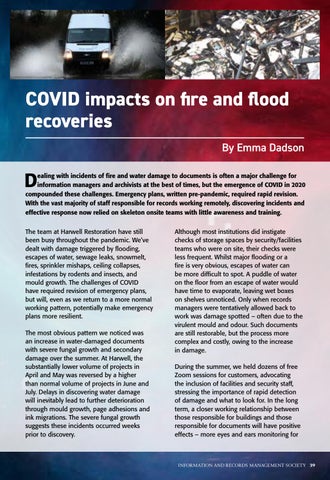COVID impacts on fire and flood recoveries By Emma Dadson
D
ealing with incidents of fire and water damage to documents is often a major challenge for information managers and archivists at the best of times, but the emergence of COVID in 2020 compounded these challenges. Emergency plans, written pre-pandemic, required rapid revision. With the vast majority of staff responsible for records working remotely, discovering incidents and effective response now relied on skeleton onsite teams with little awareness and training. The team at Harwell Restoration have still been busy throughout the pandemic. We’ve dealt with damage triggered by flooding, escapes of water, sewage leaks, snowmelt, fires, sprinkler mishaps, ceiling collapses, infestations by rodents and insects, and mould growth. The challenges of COVID have required revision of emergency plans, but will, even as we return to a more normal working pattern, potentially make emergency plans more resilient. The most obvious pattern we noticed was an increase in water-damaged documents with severe fungal growth and secondary damage over the summer. At Harwell, the substantially lower volume of projects in April and May was reversed by a higher than normal volume of projects in June and July. Delays in discovering water damage will inevitably lead to further deterioration through mould growth, page adhesions and ink migrations. The severe fungal growth suggests these incidents occurred weeks prior to discovery.
Although most institutions did instigate checks of storage spaces by security/facilities teams who were on site, their checks were less frequent. Whilst major flooding or a fire is very obvious, escapes of water can be more difficult to spot. A puddle of water on the floor from an escape of water would have time to evaporate, leaving wet boxes on shelves unnoticed. Only when records managers were tentatively allowed back to work was damage spotted – often due to the virulent mould and odour. Such documents are still restorable, but the process more complex and costly, owing to the increase in damage. During the summer, we held dozens of free Zoom sessions for customers, advocating the inclusion of facilities and security staff, stressing the importance of rapid detection of damage and what to look for. In the long term, a closer working relationship between those responsible for buildings and those responsible for documents will have positive effects – more eyes and ears monitoring for
INFORMATION AND RECORDS MANAGEMENT SOCIETY 39




